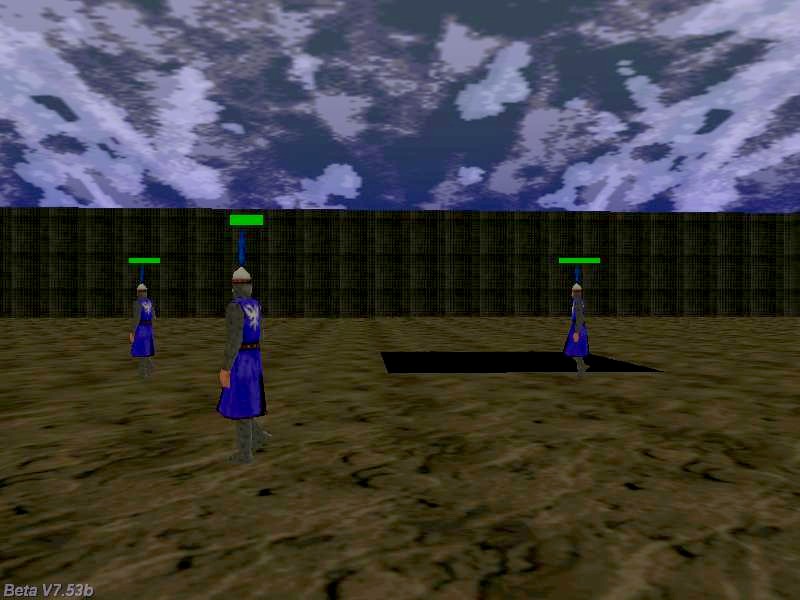Q: Is it possible to play a movie inside the level when the player comes close to a certain entity (the exit gate)?
A: Sure, take a look at the code below.
// attach this action to a sprite that has the same size with your movie
action movie_gate()
{
// wait until the player entity is loaded in the level
while (!player) {wait (1);}
// wait until the player comes close to the exit gate
while (vec_dist(player.x, my.x) > 150) {wait (1);}
// now play the movie file
media_play("mymovie.avi", bmap_for_entity (my, 0), 100); // use your own movie name here
}
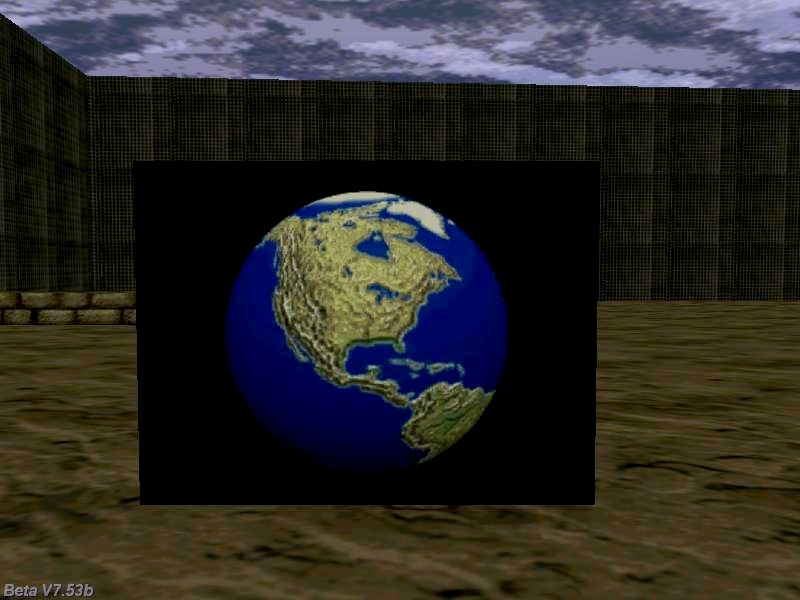
Q: How can I generate random passwords using lite-C?
A: Here's an example.
var password_length = 8; // generate passwords that contain 8 characters, play with this number
STRING* password_str = "#30"; // stores passwords with up to 30 characters
STRING* temp_str = " ";
FONT* arial_font = "Arial#20";
TEXT* password_txt =
{
pos_x = 20;
pos_y = 20;
font = arial_font;
string(password_str);
flags = VISIBLE;
}
// press any key to generate a new password
function passwords_startup()
{
var i, temp;
randomize();
while (1)
{
while (key_any) {wait (1);} // wait until all the keys are released
while (!key_any) {wait (1);} // wait until a key is pressed
str_cpy(password_str, "#30"); // reset password_str
i = 0;
while (i < password_length) // generate a number of 8 characters for our password
{
// generate a random ascii code (visible, printable characters only)
temp = integer(random(95)) + 32;
str_for_asc(temp_str, temp); // convert the random number to its string equivalent
str_cat(password_str, temp_str);
i++;
}
}
}
Q: I'd like to create a 2D arkanoid clone, but I hate the idea of defining hundreds of panels. Isn't there an easier way?
A: Use pan_create to create and place your panels easily.
PANEL* temp_pan;
// these numerical values work fine for a screen resolution of 800 x 600 pixels
function aliens_startup()
{
var temp1 = 30; // temp1 gives the coordinates of the first brick on the x axis
var temp2 = 20; // temp2 gives the coordinates of the first brick on the y axis
// create rows of bricks until their y exceeds 300
while (temp2 < 300)
{
// generate bricks until their x exceeds 760
while (temp1 < 760)
{
// block.pcx has 32 x 16 pixels in my example, but you can use any other size for the bitmap
temp_pan = pan_create("bmap = block.pcx; flags = overlay, visible;", 10);
temp_pan.pos_x = temp1;
temp_pan.pos_y = temp2;
temp1 += 50;
}
temp1 = 30;
temp2 += 40;
}
}
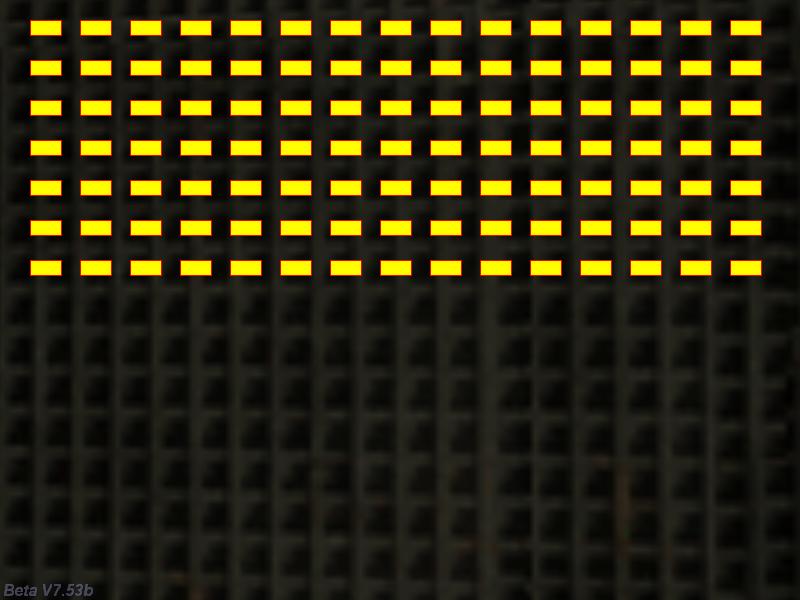
Q: My player model has 3 animations: "walk", "stand" and "look". I'd like it to "walk" when the movement keys are played, "stand" when it stops and "look" after a longer period of inactivity. How can I do that?
A: Use this player / camera example as a base for your code.
action players_code()
{
VECTOR temp[3];
VECTOR movement_speed[3]; // player's movement speed
var anim_percentage; // animation percentage
var distance_to_ground;
var time_passed = 0;
player = my; // I'm the player
while (1)
{
my.pan += 6 * (key_a - key_d) * time_step; // rotate the player using the "A" and "D" keys
vec_set (temp.x, my.x); // copy player's position to temp
temp.z -= 10000; // set temp.z 10000 quants below player's origin
distance_to_ground = c_trace (my.x, temp.x, IGNORE_ME | USE_BOX);
movement_speed.x = 5 * (key_w - key_s) * time_step; // move the player using "W" and "S"
movement_speed.y = 0; // don't move sideways
movement_speed.z = -(distance_to_ground - 20); // 20 = experimental value
c_move (my, movement_speed.x, nullvector, GLIDE); // move the player
if (!key_w && !key_s) // the player isn't moving?
{
time_passed += time_step / 16; // add "1" to time_passed every second
if (time_passed >= 20) // at least 20 seconds have passed?
{
anim_percentage += 3 * time_step; // 3 = "look" animation speed
ent_animate(my, "look", anim_percentage, ANM_CYCLE); // then play the "look" animation
}
else // the player is standing
{
anim_percentage += 2 * time_step; // 2 = "stand" animation speed
ent_animate(my, "stand", anim_percentage, ANM_CYCLE);
}
}
else // the player is moving?
{
time_passed = 0;
ent_animate(my, "walk", anim_percentage, ANM_CYCLE); // play the "walk" animation
anim_percentage += 5 * time_step; // 5 = "walk" animation speed
}
// camera code
camera.x = player.x - 250 * cos(player.pan);
camera.y = player.y - 250 * sin(player.pan); // use the same value (250) here
camera.z = player.z + 150; // place the camera above the player, play with this value
camera.tilt = -20; // look down at the player
camera.pan = player.pan;
wait (1);
}
}
Q: I'd like my npc to move from A to B, stopping at certain points on the path for a specified number of seconds. How can I do that?
A: Place your npc in the level and assign it the action named "patroller". Create a virtual path from A to B using small entities, attach them the action named "target_init" and set their skill1 to the waiting time (in seconds), if needed.
ENTITY* my_target;
action patroller()
{
VECTOR temp[3];
while (1)
{
// scan for camera positions that are placed up to 1000 quants away from this entity
c_scan(my.x, my.pan, vector(360, 60, 1000), IGNORE_ME | SCAN_ENTS | SCAN_LIMIT);
if (you) // a target was detected?
{
my_target = you; // the closest position to the npc is set to "you" by c_scan
my_target.scale_z = 4;
vec_set(temp, my_target.x);
vec_sub(temp, my.x);
vec_to_angle(my.pan, temp); // rotate the patroller towards the position
my.tilt = 0; // but don't allow it to change its tilt angle
// the patroller looks at its target now
while (vec_dist (my.x, my_target.x) > 50) // the patroller moves until it comes close to the target
{
my.skill22 += 5 * time_step; // 5 gives the "walk" animation speed
c_move(my, vector(5 * time_step, 0, 0), nullvector, IGNORE_PASSABLE | GLIDE); // 5 = movement speed
ent_animate(my, "walk", my.skill22, ANM_CYCLE);
wait (1);
}
// the patroller has come close to target here
my.skill99 = 0;
while (my.skill99 < my_target.skill1)
{
my.skill99 += time_step / 16;
ent_animate(my, "stand", my.skill22, ANM_CYCLE);
my.skill22 += 3 * time_step; // 3 gives the "stand" animation speed
wait (1);
}
ent_remove(my_target); // remove the current target and prepare for the following target
}
else // reached the end of the path?
{
ent_animate(my, "stand", my.skill22, ANM_CYCLE); // then default to standing
my.skill22 += 3 * time_step; // 3 gives the "stand" animation speed
}
wait (1);
}
}
action target_init()
{
set (my, PASSABLE | INVISIBLE); // player's movement code should ignore passable entities
my.emask |= ENABLE_SCAN; // the target entity is sensitive to c_scan instructions
}
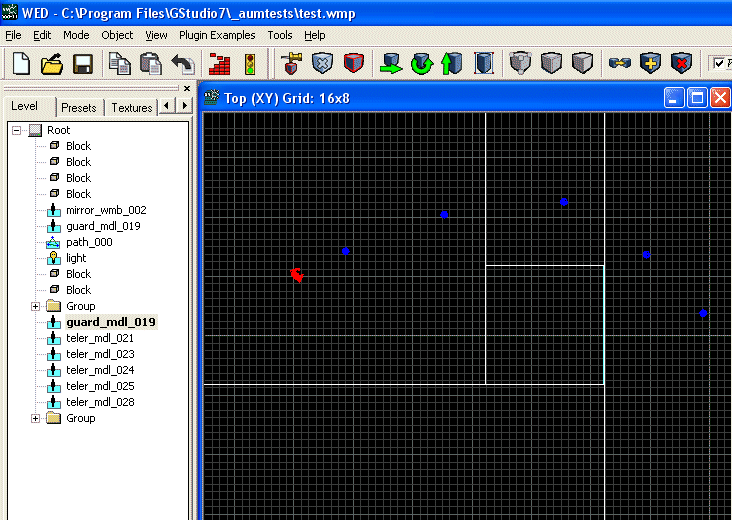
Q: I'd like to have some targets (sprites) that rotate around their pan angles when they are shot. Can you help?
A: Sure; use the code below.
SOUND* bullet_wav = "bullet.wav";
function fire_bullets()
{
VECTOR trace_coords[3];
vec_set(trace_coords.x, vector(5000, 0, 0)); // trace 5000 quants in front of the player
// rotate "trace_coords"
vec_rotate(trace_coords.x, camera.pan);
vec_add(trace_coords.x, player.x); // add the resulting vector to player's position
snd_play(bullet_wav, 70, 0); // play the bullet sound
if (c_trace (player.x, trace_coords.x, IGNORE_ME + USE_BOX) > 0) // the "c_trace" ray has hit something?
{
if (you) // and the hit object is an entity?
{
if (you.skill1 == 99) // and the hit entity has its skill1 set to 99?
{
you.skill50 = 30; // 30 = maximum rotation speed
}
}
}
}
action players_code()
{
on_mouse_left = fire_bullets;
player = my; // I'm the player
set (my, INVISIBLE); // no need to see player's model in 1st person mode
while (1)
{
// move the player using the "W", "S", "A" and "D" keys; "10" = movement speed, "6" = strafing speed
c_move (my, vector(10 * (key_w - key_s) * time_step, 6 * (key_a - key_d) * time_step, 0), nullvector, GLIDE);
vec_set (camera.x, player.x); // use player's x and y for the camera as well
camera.z += 30; // place the camera 30 quants above the player on the z axis (approximate eye level)
camera.pan -= 5 * mouse_force.x * time_step; // rotate the camera around by moving the mouse
camera.tilt += 3 * mouse_force.y * time_step; // on its x and y axis
player.pan = camera.pan; // the camera and the player have the same pan angle
wait (1);
}
}
action shooting_target()
{
my.skill1 = 99; // this entity will rotate around its axis
while (1)
{
while (my.skill50 <= 0) {wait (1);} // the entity waits until it is shot by the player
while (my.skill50 > 0)
{
my.pan += my.skill50 * time_step; // rotate the entity around its pan angle
my.skill50 -= 0.5 * time_step; // decrease the rotation speed as the time passes
wait (1);
}
}
}
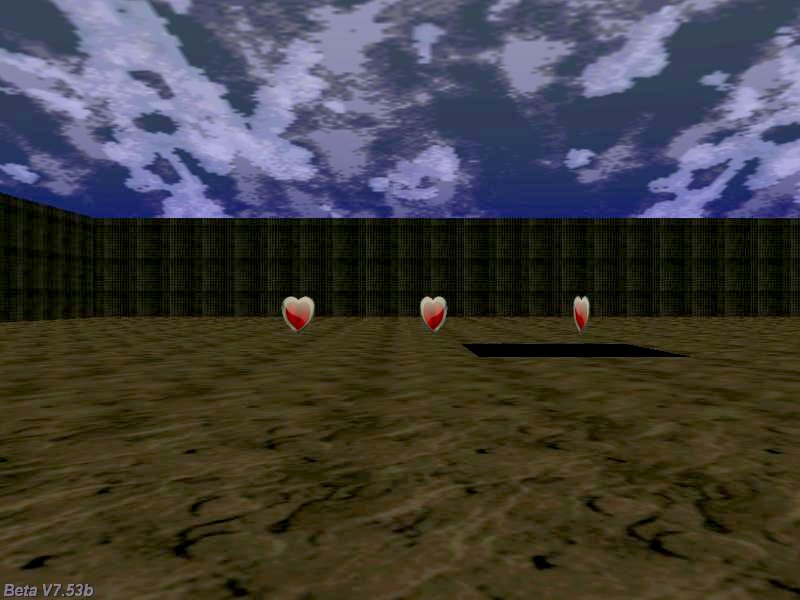
Q: How can I see the c_scan range for an entity? I'd like to have some visual pointers, if possible.
A: Get the triangle.mdl from this months' "Resources" and use it together with the code below; it displays the horizontal scanning sector and the scanning distance.
function scan_view()
{
proc_kill(4); // follow the entity smoothly
set(my, PASSABLE | TRANSLUCENT);
my.alpha = 20;
while (you)
{
my.x = you.x;
my.y = you.y;
my.z = you.z - 35; // move the triangle at the floor level
my.pan = you.pan;
my.tilt = you.tilt;
my.scale_x = you.skill3 / 10; // set the proper scale_x and scale_y for the triangle model
my.scale_y = 2 * you.skill3 * tan(you.skill1 / 2) / 10; // scale_y = 2 * d * tg (alpha / 2)
wait (1);
}
}
action my_entity() // simple entity code, makes it rotate around while scanning the area
{
my.skill1 = 30; // horizontal angle
my.skill2 = 20; // vertical angle
my.skill3 = 200; // scanning range
VECTOR temp[3];
// create the triangular area using a triangle that has a size of 10 pixels
ent_create("triangle.mdl", nullvector, scan_view);
while (1)
{
c_scan(my.x, my.pan, my.skill1, IGNORE_ME | SCAN_ENTS | SCAN_LIMIT);
c_move(my, vector(5 * time_step, 0, 0), nullvector, IGNORE_PASSABLE | GLIDE); // 5 = movement speed
my.skill22 += 5 * time_step; // 5 gives the "walk" animation speed
my.pan += 1 * time_step;
ent_animate(my, "walk", my.skill22, ANM_CYCLE);
wait (1);
}
}
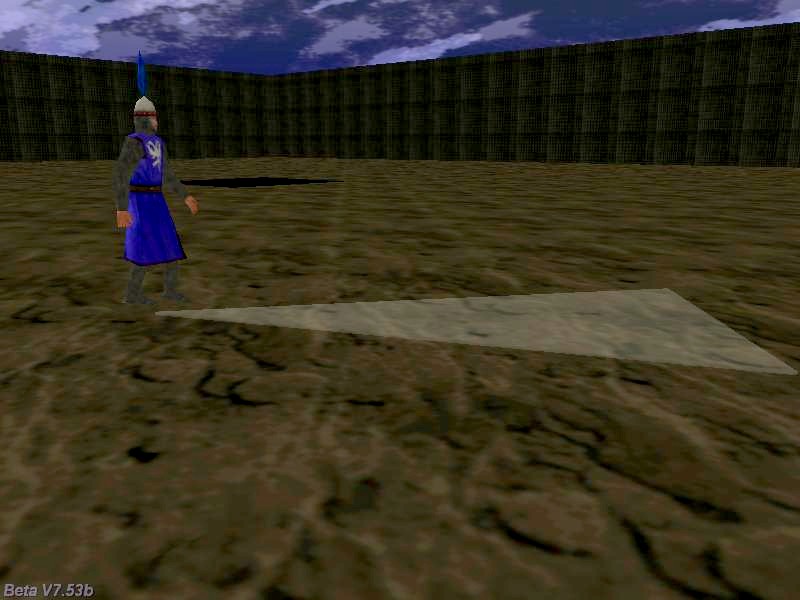
Q: I've been playing Guild Wars and I have noticed that they have intelligent NPCs that walk, stop in front of walls, and then change their directions and move away. Could something similar be achieved using GameStudio?
A: Take a look at the code below; it does exactly what you need.
action intelligent_npc() // stops in front of the wall, and then changes its direction
{
VECTOR front_pos;
var distance_covered;
while (1)
{
vec_set(front_pos.x, vector(50, 0, 0)); // compute a vector that's 50 quants in front of the player
// rotate "front_pos" in the direction (angles) given by the entity
vec_rotate(front_pos.x, my.pan);
vec_add(front_pos.x, my.x); // add the resulting vector to entity's position
if (c_content(front_pos.x, 0) == 1) // front_pos isn't touching any walls?
{
// 5 gives the movement speed
distance_covered = c_move(my, vector(5 * time_step, 0, 0), nullvector, IGNORE_PASSABLE | GLIDE);
my.skill22 += 5 * time_step; // 5 gives the "walk" animation speed
ent_animate(my, "walk", my.skill22, ANM_CYCLE);
}
else // the player is close to a wall now?
{
my.skill99 = 0;
while (my.skill99 < 5) // stays in front of the wall for 5 seconds
{
my.skill99 += time_step / 16;
ent_animate(my, "stand", my.skill22, ANM_CYCLE);
my.skill22 += 3 * time_step; // 3 gives the "stand" animation speed
wait (1);
}
my.skill99 = my.pan;
my.skill99 += random(180);
while (my.pan < my.skill99)
{
my.pan += 5 * time_step;
wait (1);
}
}
wait (1);
}
}
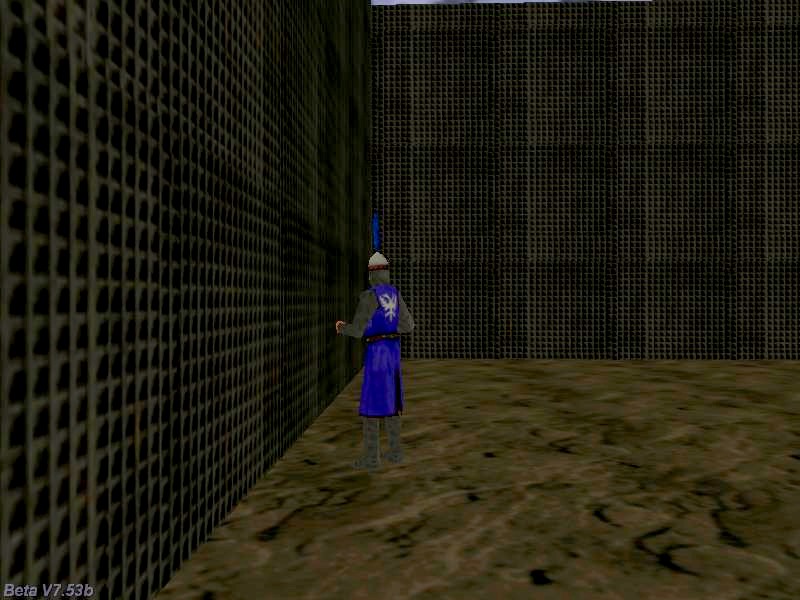
Q: I've got the player surrounded by enemies, but I'm having a hard time trying to detect what enemy the player is facing. Can you help me please?
A: The following snippet computes the pan angle difference between each enemy and the player. When this difference is in the 150...210 degrees range (180 + or - 30 degrees) that enemy is facing the player; the code sets scale_z to 1.5 for that particular enemy.
action player_code() // attach this action to your player
{
var movement_speed = 10; // movement speed
VECTOR temp;
player = my; // I'm the player
while (1)
{
temp.x = movement_speed * (key_cuu - key_cud) * time_step;
temp.y = 0;
temp.z = 0;
my.pan += 4 * (key_cul - key_cur) * time_step;
c_move (my, temp.x, nullvector, IGNORE_PASSABLE | GLIDE);
wait (1);
}
}
// simple enemy action; surround the player with several models that have this action attached to them
action my_enemy()
{
VECTOR temp;
while (!player) {wait (1);}
while (1)
{
vec_set(temp, player.x);
vec_sub(temp, my.x);
vec_to_angle(my.pan, temp); // rotate the enemy towards the player
my.tilt = 0; // but don't allow it to change its tilt angle
if (ang(my.pan - player.pan) > 150)
{
// the angle between the enemy and the player is in the 150...210 degrees range?
if (ang(my.pan - player.pan) < 210)
{
// then increase the z scale of the entity that is facing the player
my.scale_z = 1.5;
}
}
else // the player isn't facing this enemy
{
my.scale_z = 1; // so restore the initial scale_z value
}
wait (1);
}
}
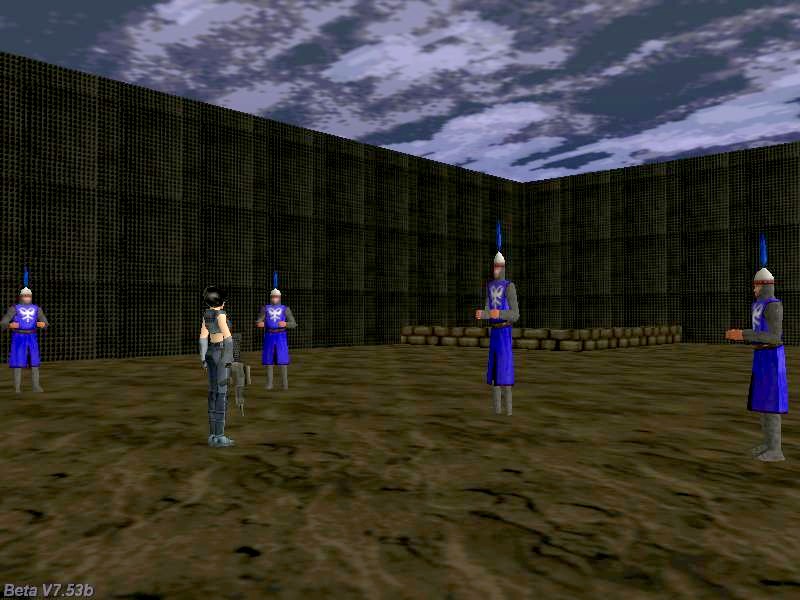
Q: Please give an example of showing local variables as panels over entities; there is too much confusion with this in the forum. Example: you have one action attached to all enemies and you want to see the health panel over them?
A: The code below uses a green sprite of 4 x 4 pixels to create a health panel above each entity. The health value is read from a local variable (entity's skill20).
#define health skill20
function health_indicator()
{
set (my, PASSABLE);
while (you)
{
vec_set (my.x, you.x);
my.z += 60;
my.scale_x = you.health * 0.1; // skill20 aka "health" stores the health for each entity
wait (1);
}
}
action my_enemy() // simple enemy action, makes it rotate in a circle
{
my.health = 10 + random(90);
ent_create ("health.pcx", nullvector, health_indicator);
while (1)
{
c_move(my, vector(5 * time_step, 0, 0), nullvector, IGNORE_PASSABLE | GLIDE); // 5 = movement speed
my.skill22 += 5 * time_step; // 5 gives the "walk" animation speed
my.pan += 1 * time_step;
ent_animate(my, "walk", my.skill22, ANM_CYCLE);
wait (1);
}
}
function randomize_startup()
{
randomize();
}
